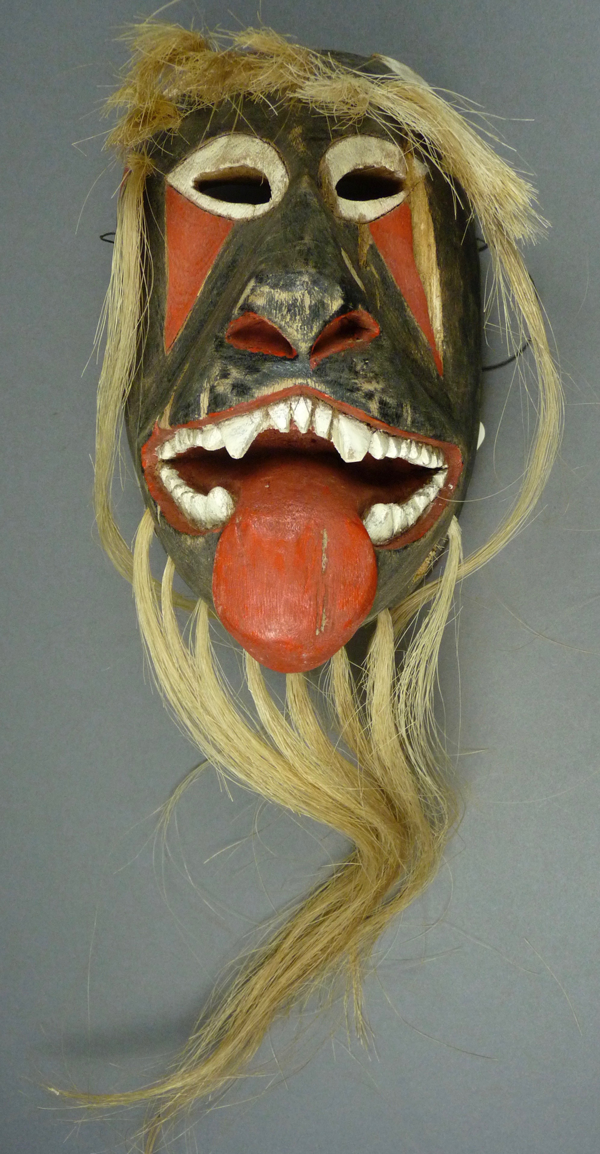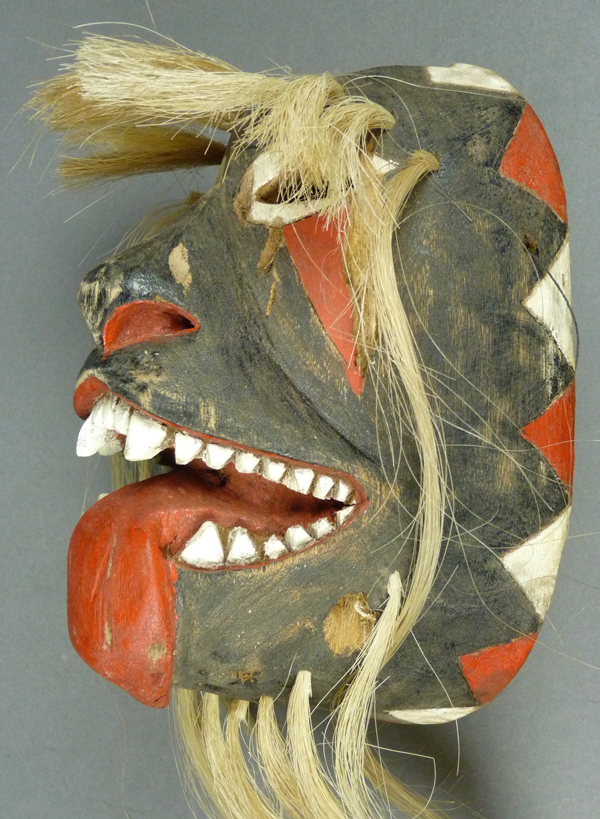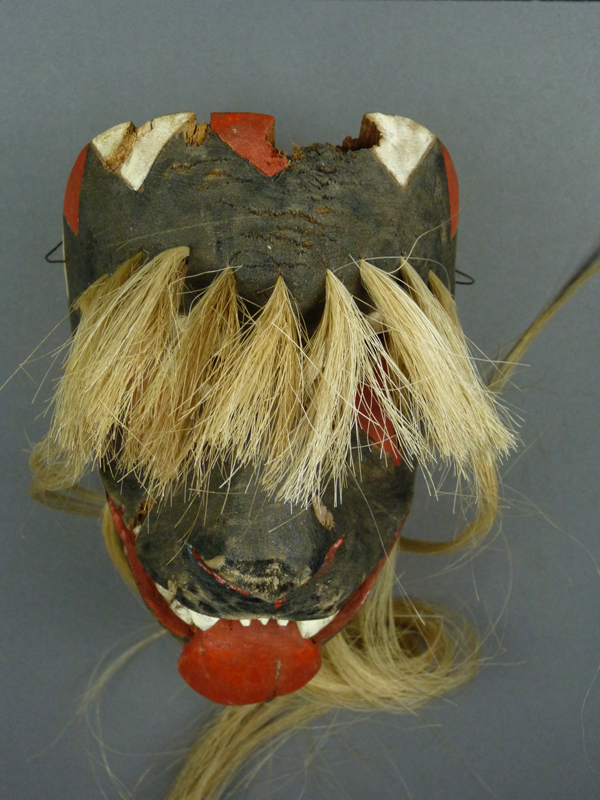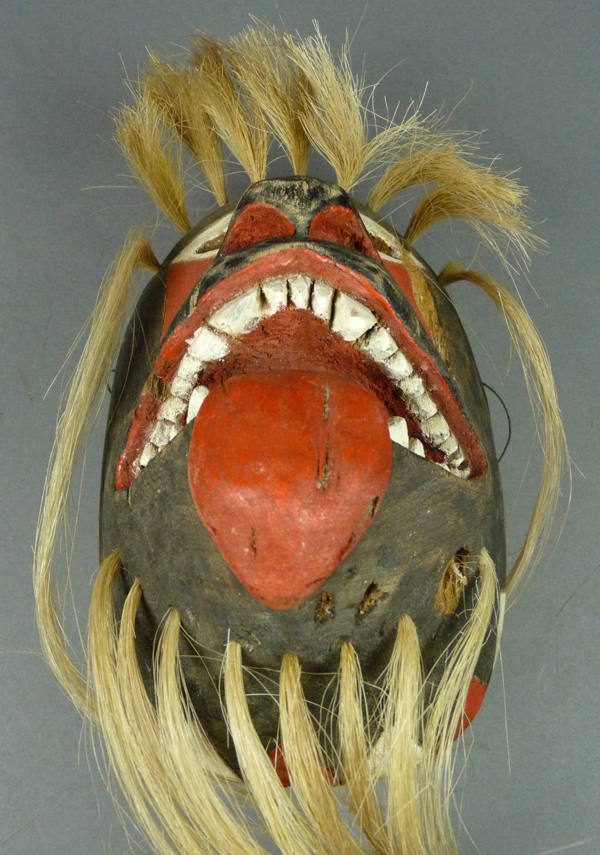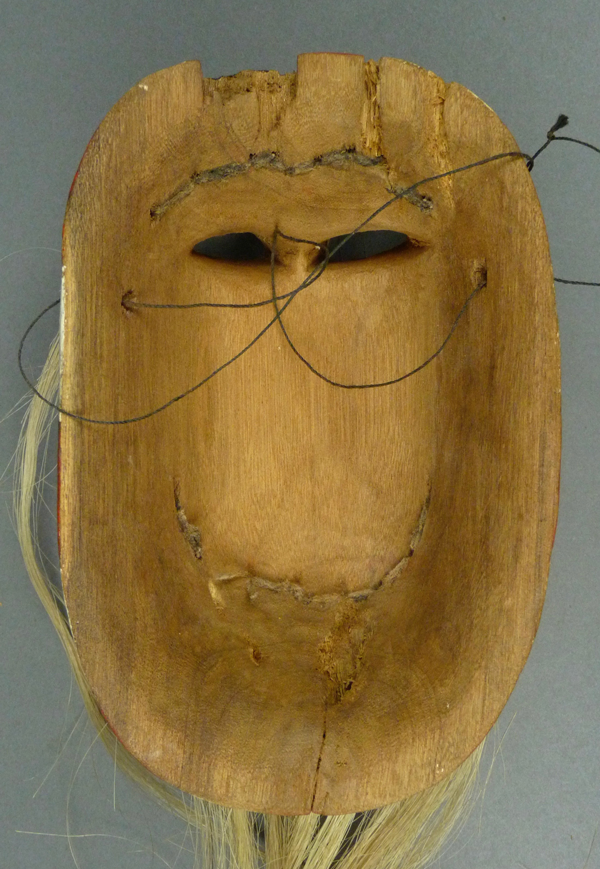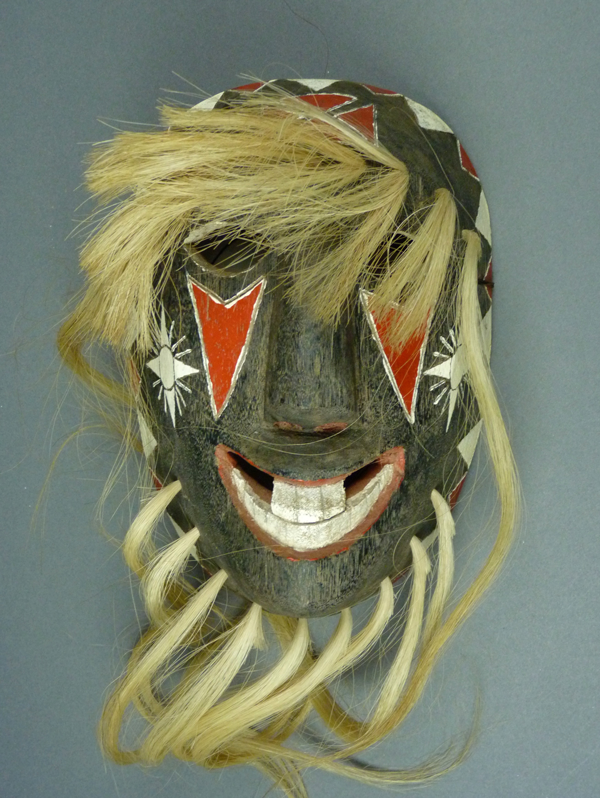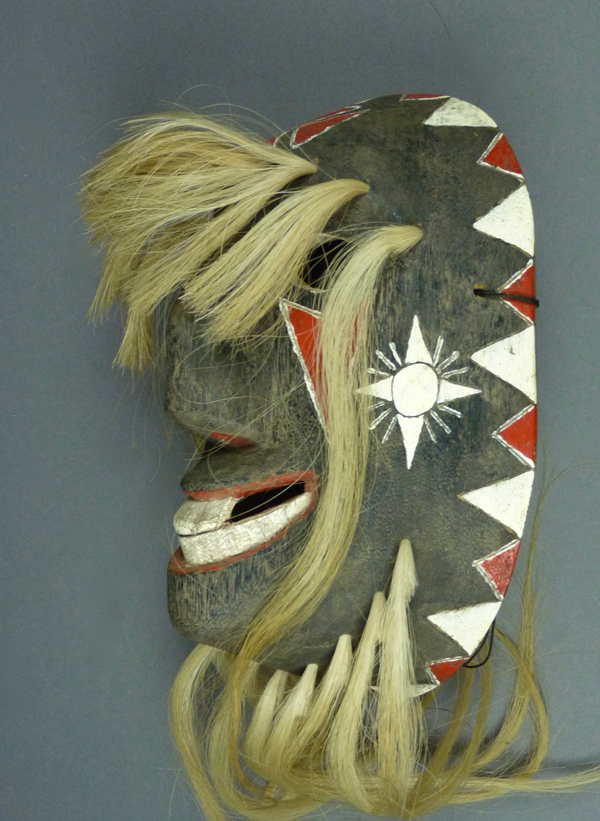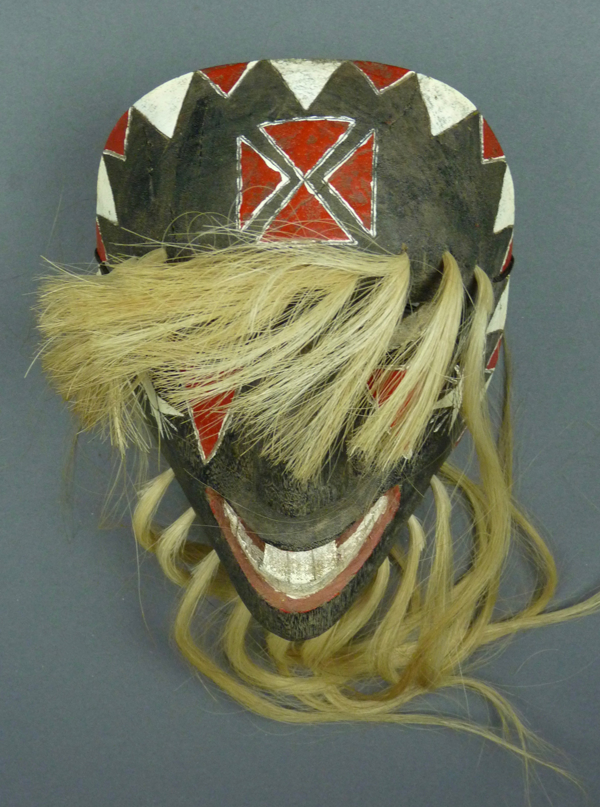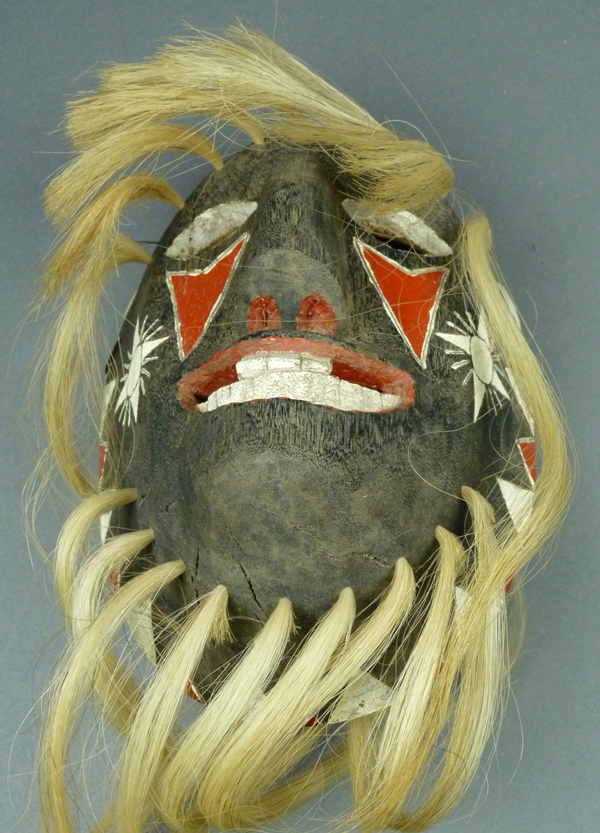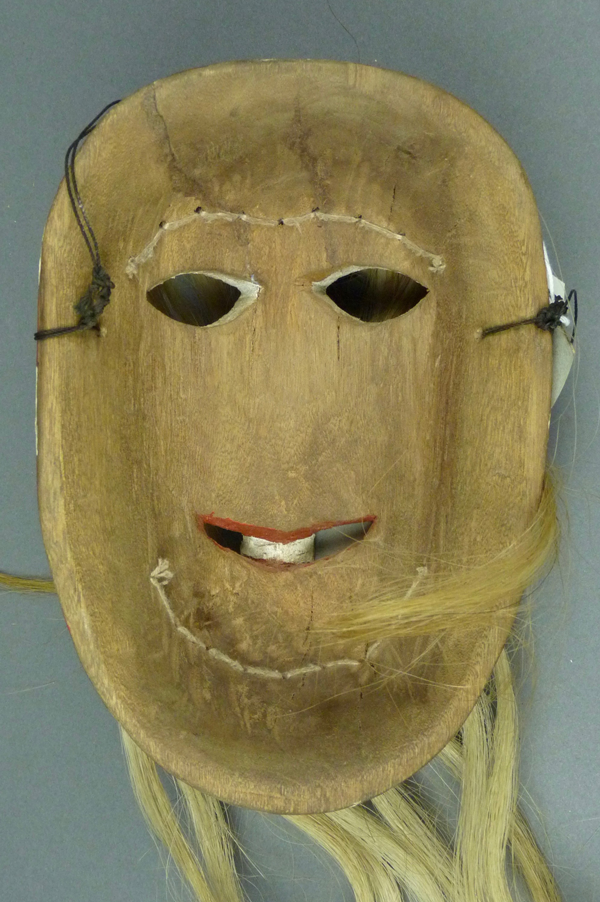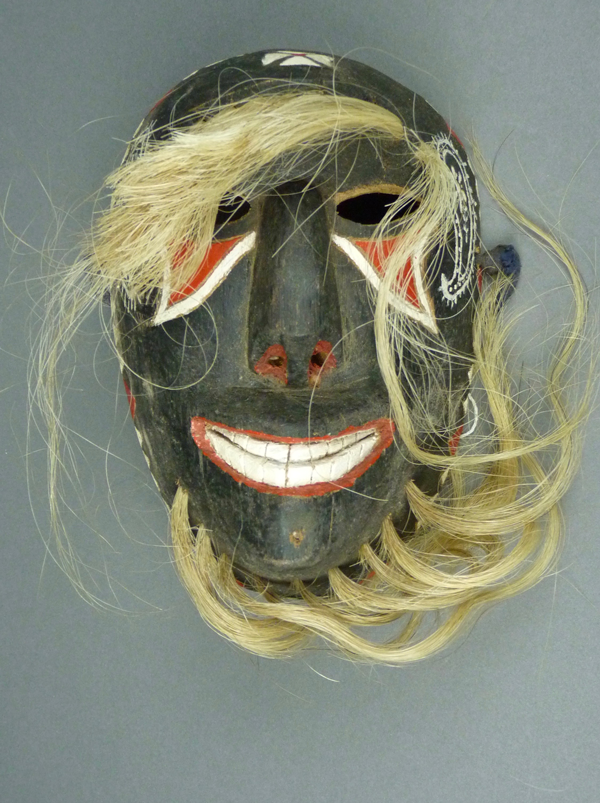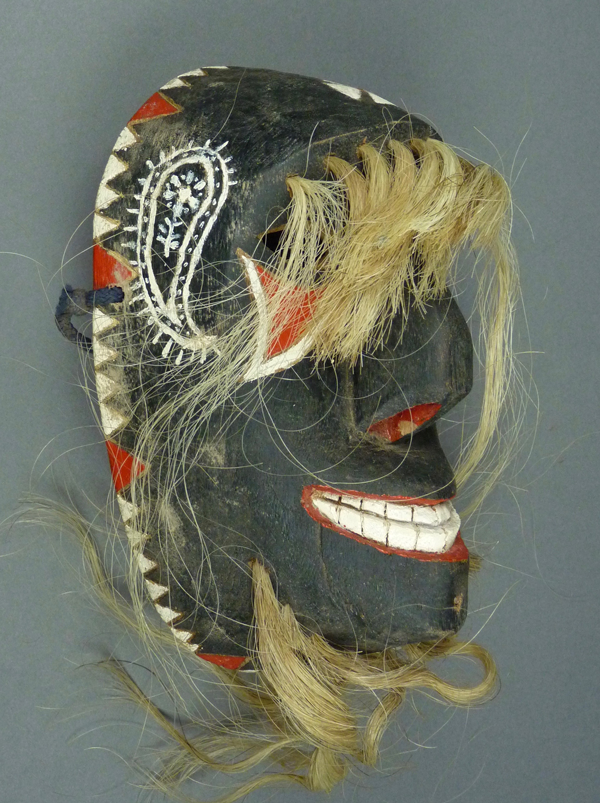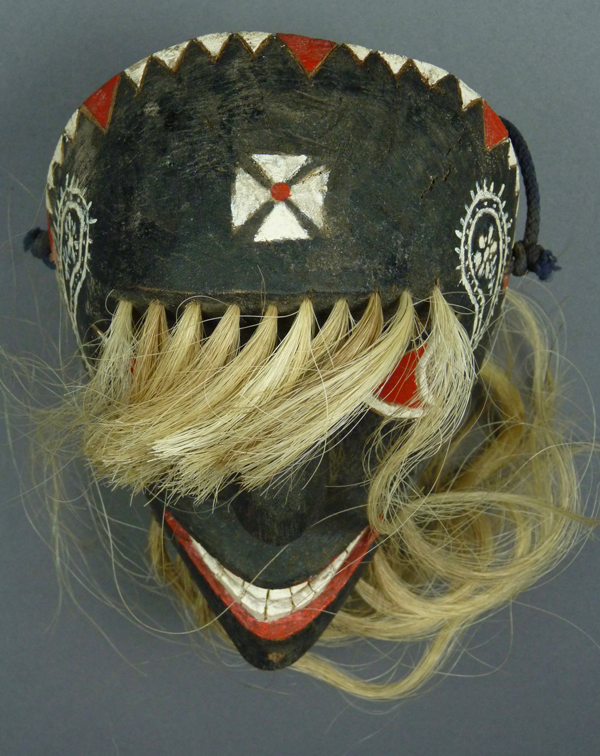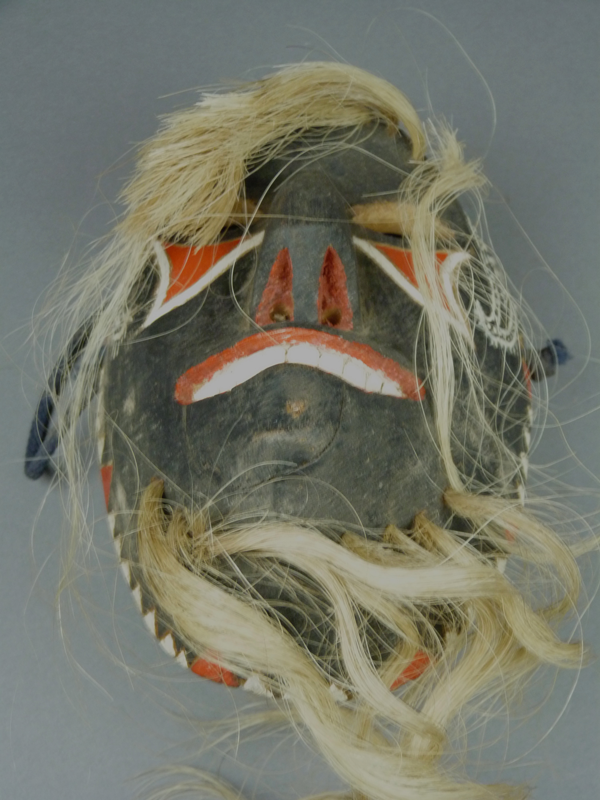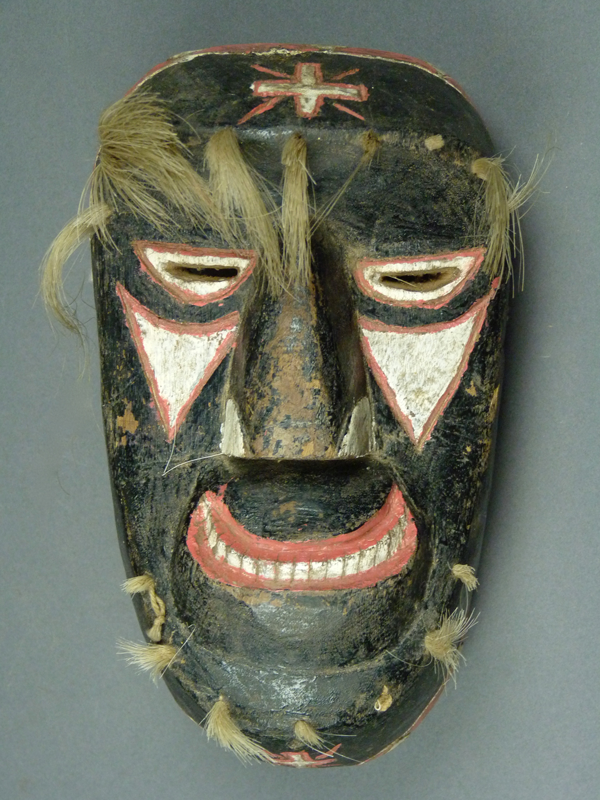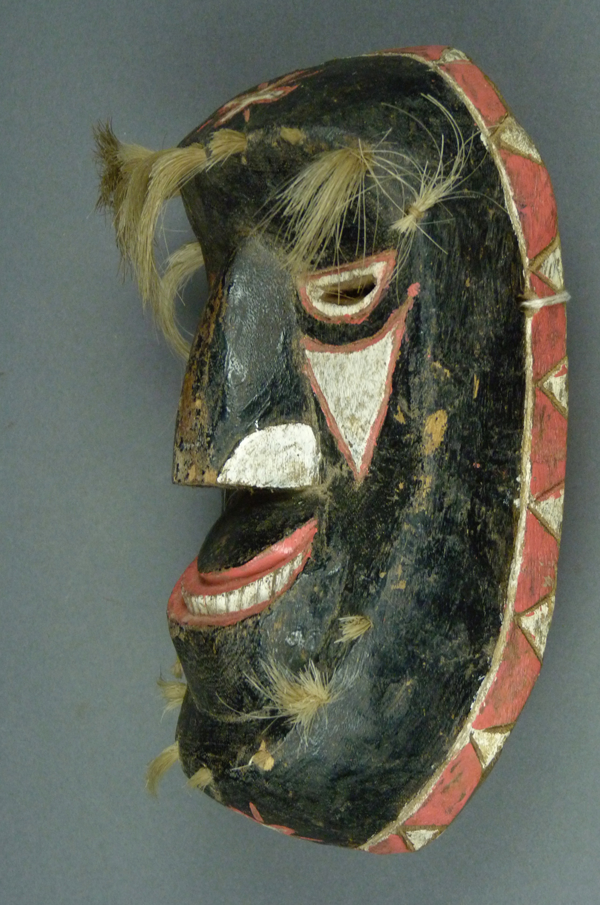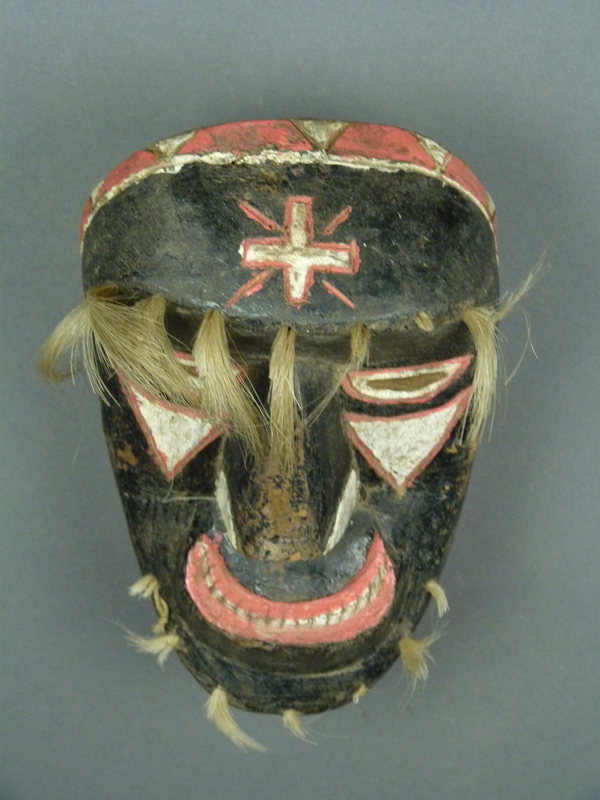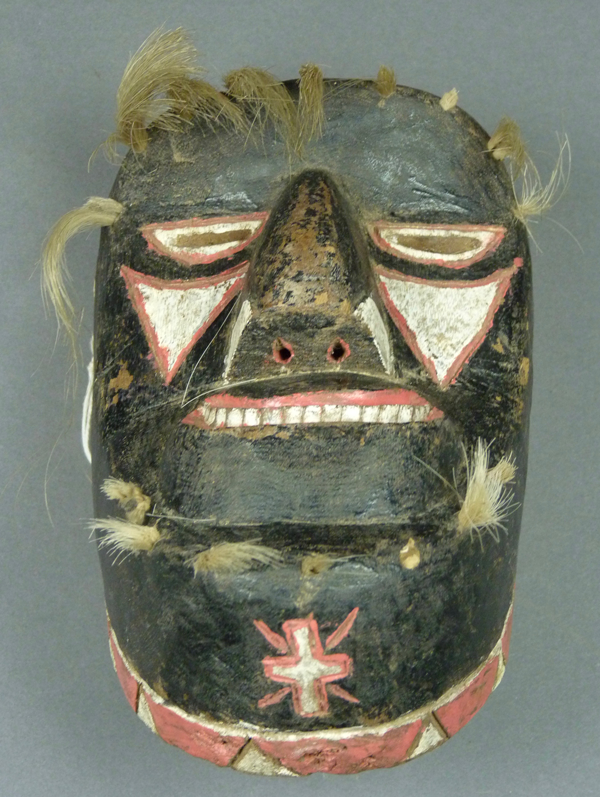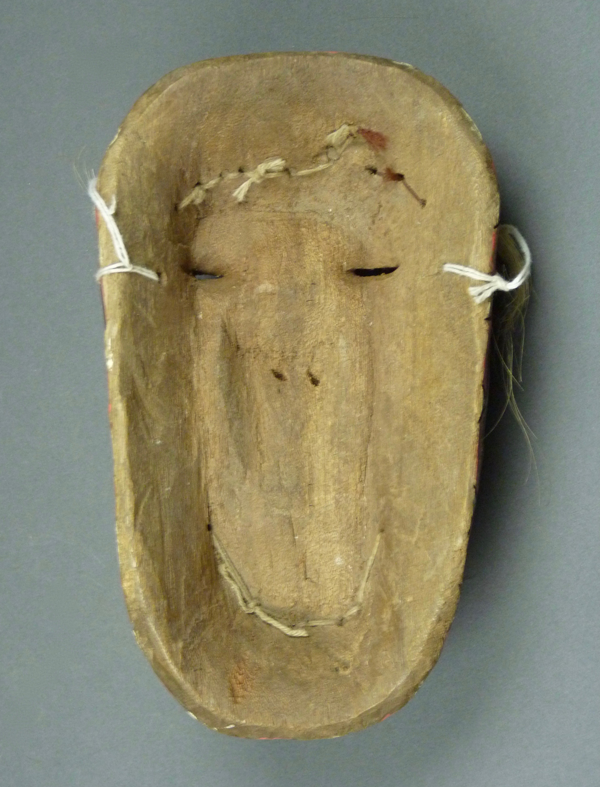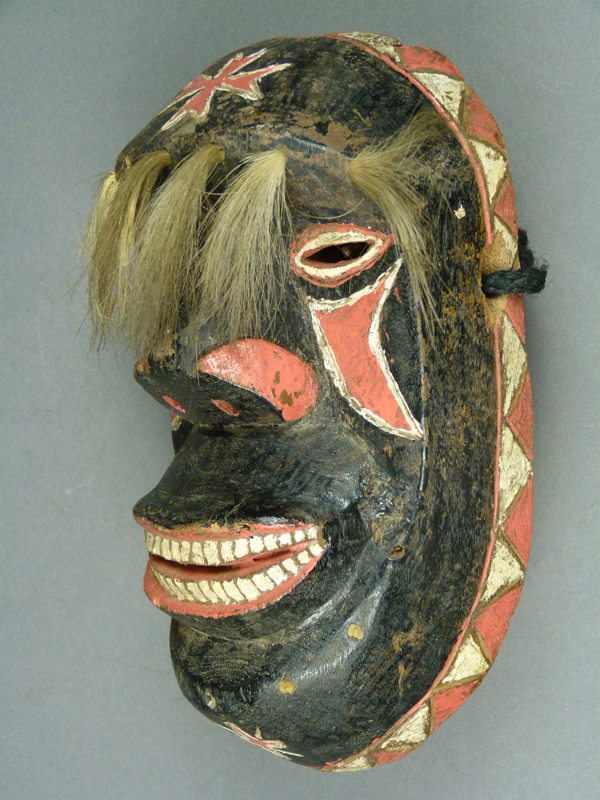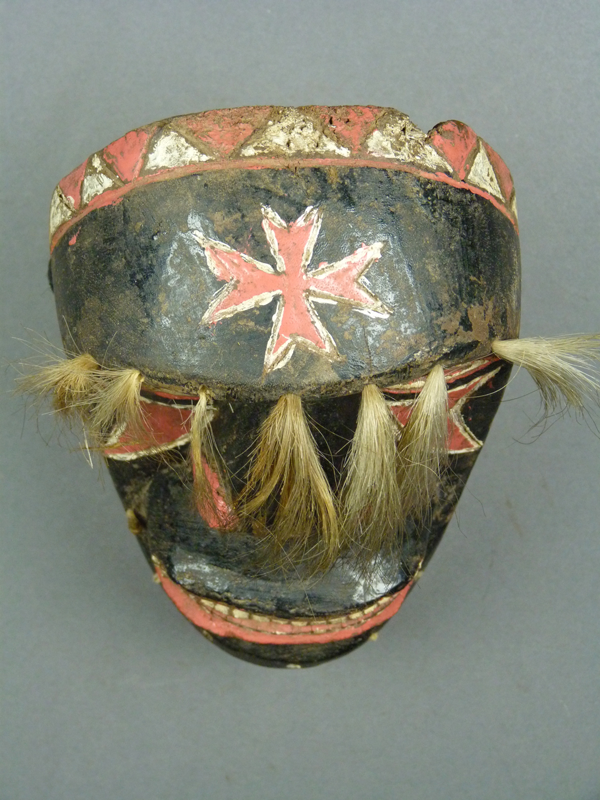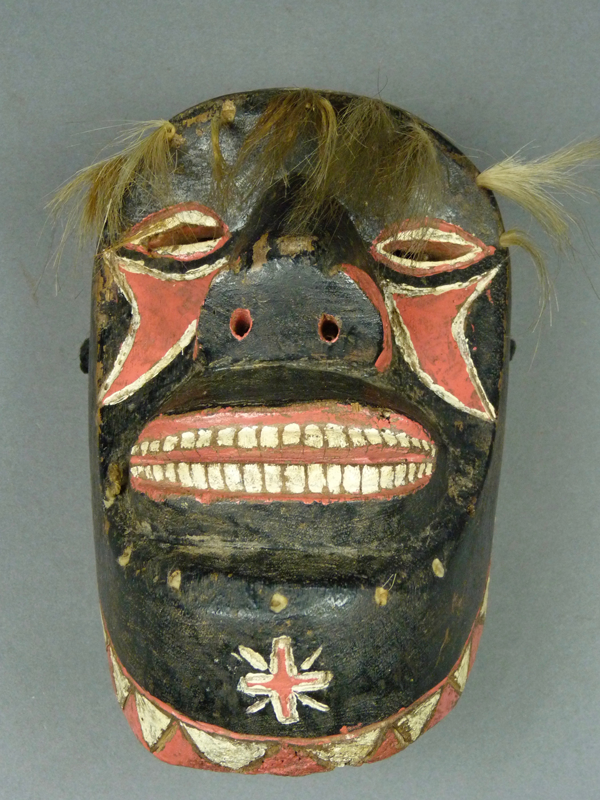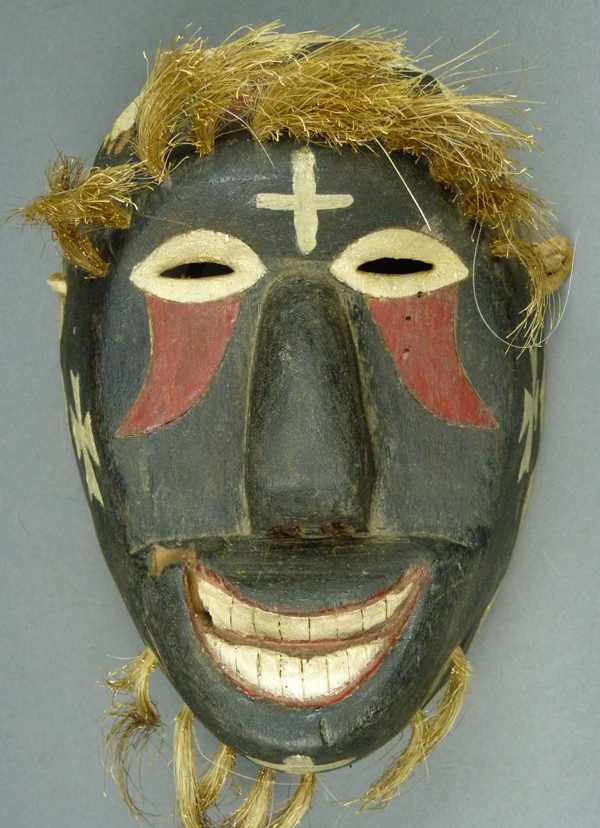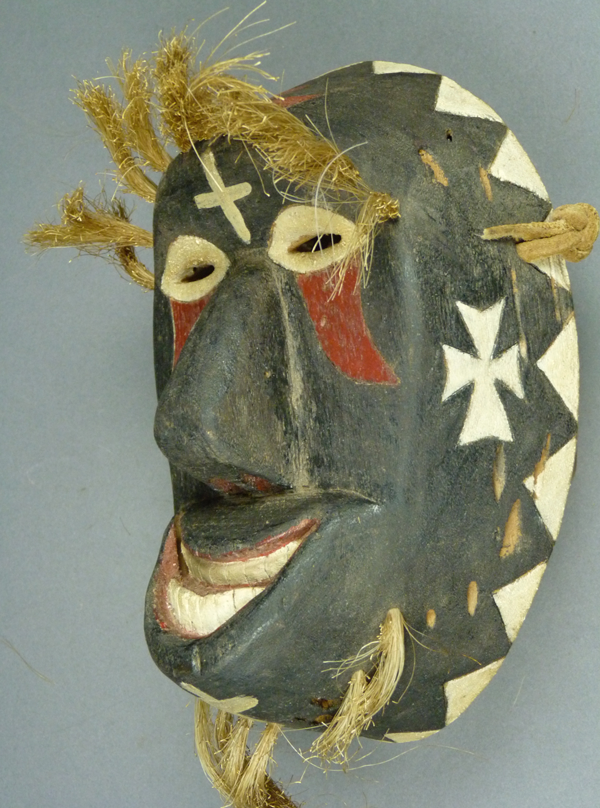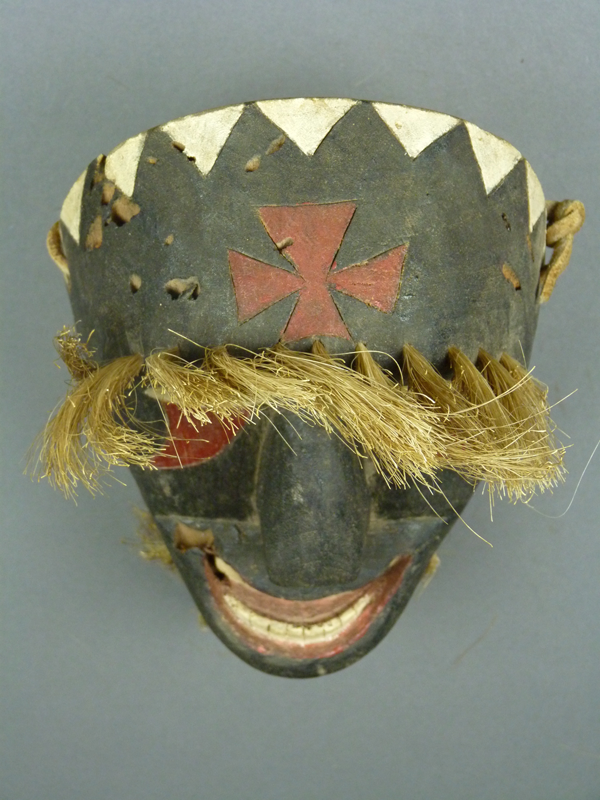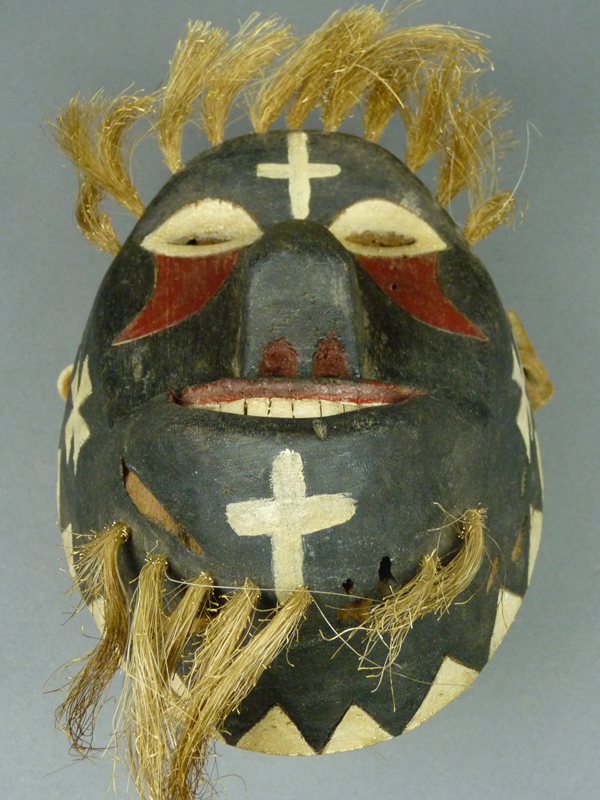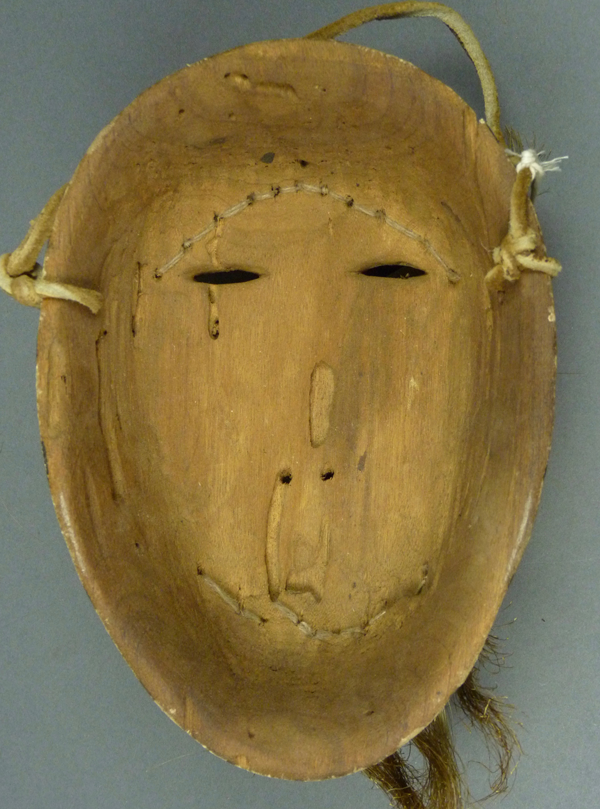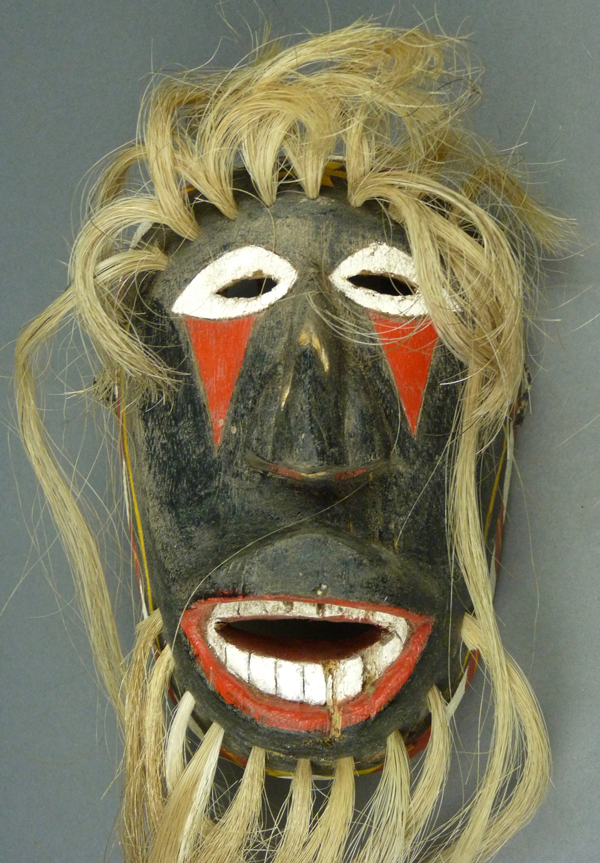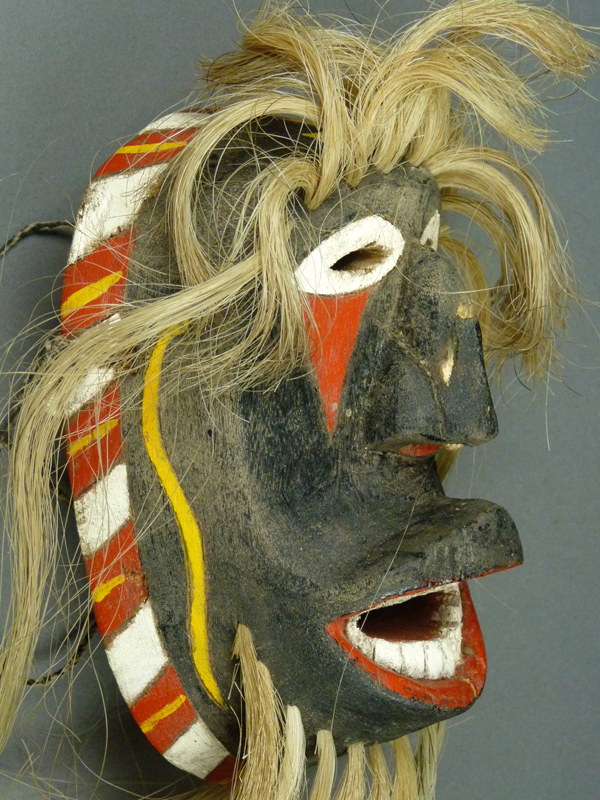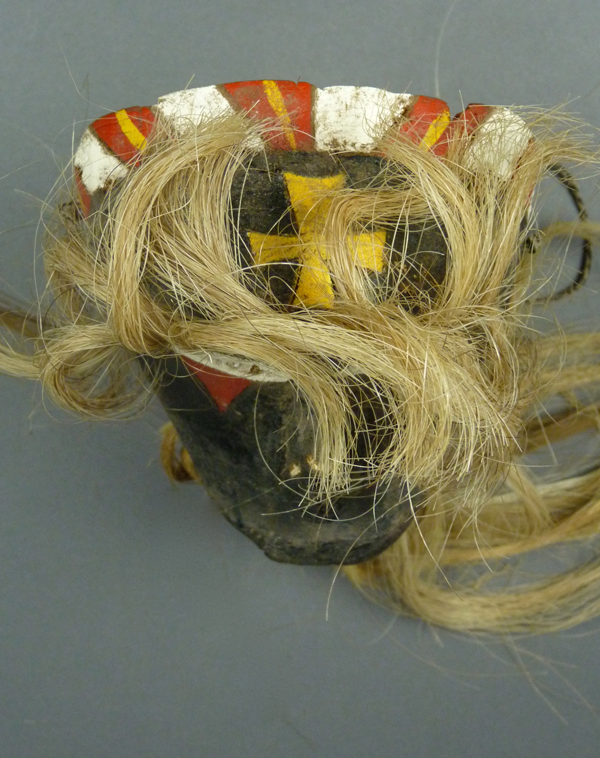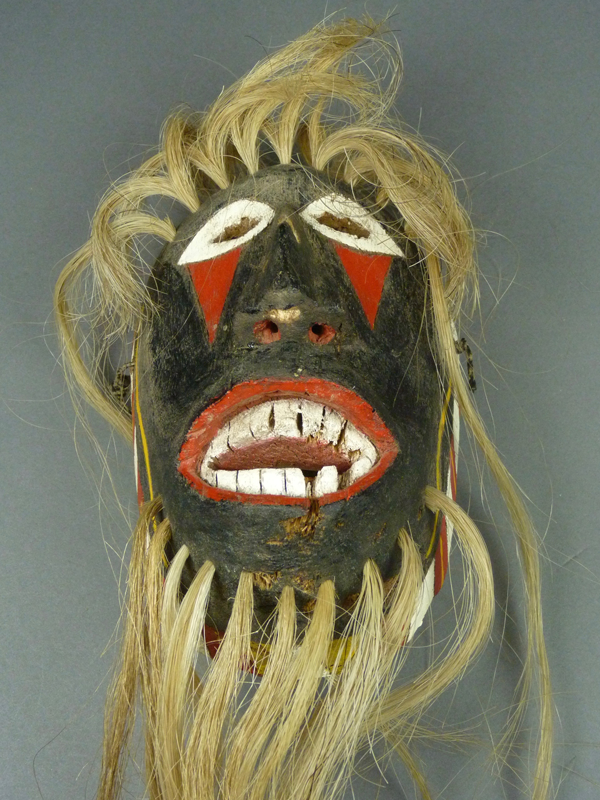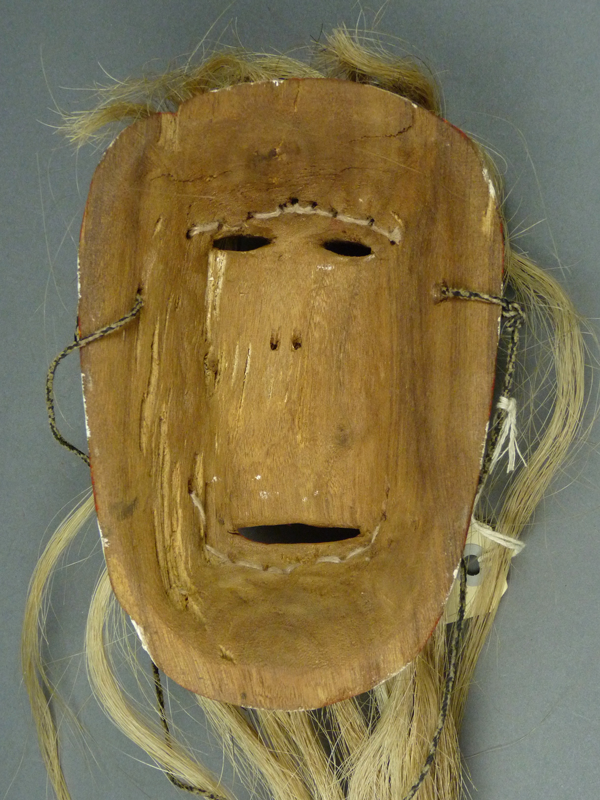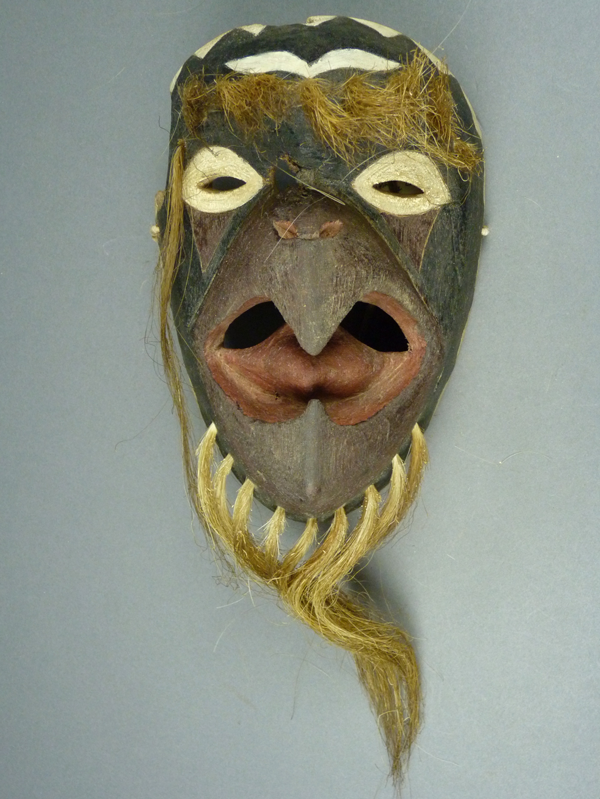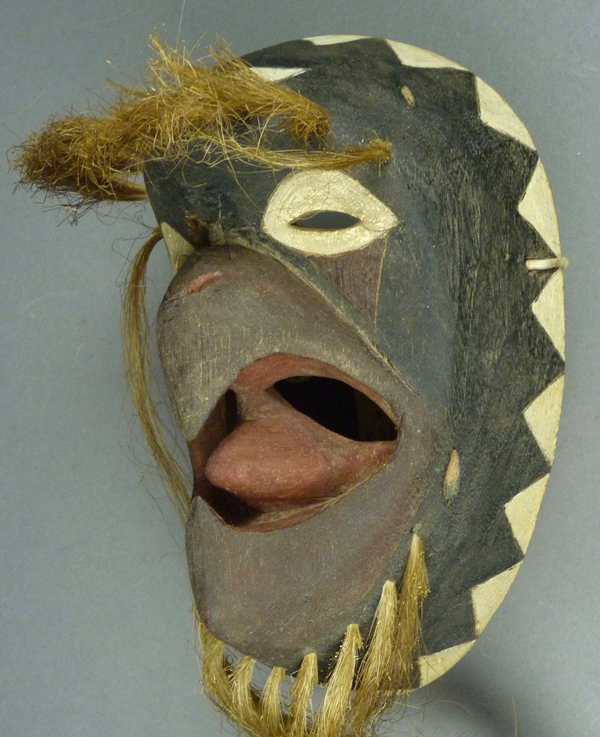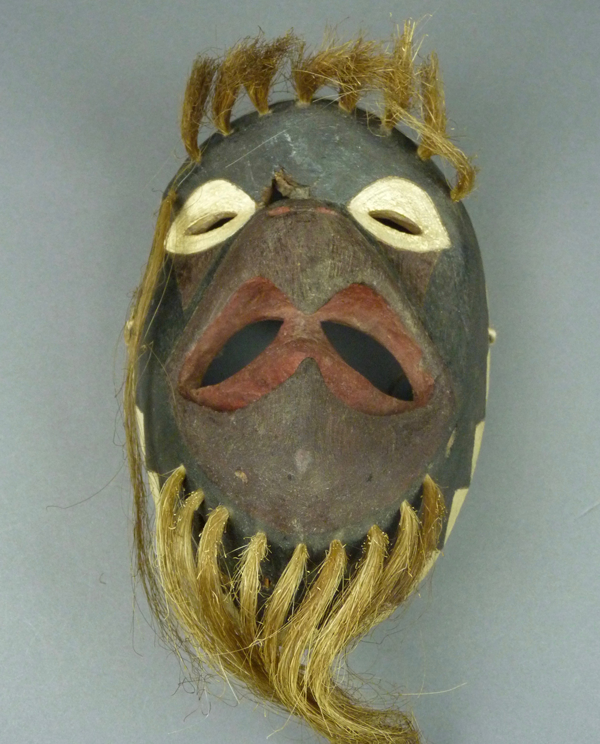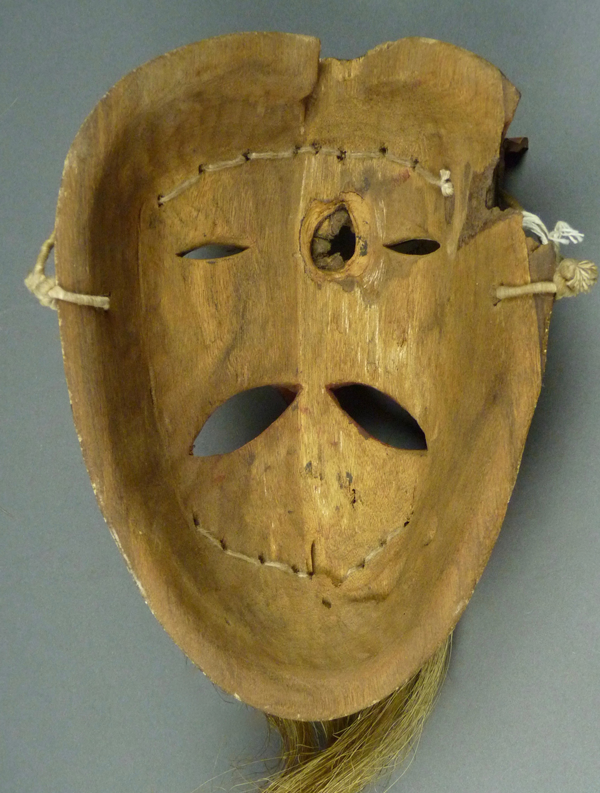Today I will show masks that have been identified as the work of Conrado Rodríguez Cupis. The first was attributed to Conrado by his family at the time of sale to Barney and Mahina Burns in 2005 (B/M 424/416).
Isn’t this a dramatic mask! The eyes look like those of Preciliano but the teeth support the family’s assignment to Conrado and the triangles under the eyes don’t curve like those of Preciliano. There is an area of damage on the left cheek.
Conrado favors such carefully carved and exaggerated nostrils, but on this mask these do not communicate with the interior of the mask, and nor does this dramatically open mouth. When such nostrils do supply air to the dancer, Conrado tends to accomplish this with simple drilled holes. The rim design features Conrado’s oversized triangles, which are well suited for this large mask. The top edge is broken.
There is no forehead or chin cross.
The teeth are carved in Conrado’s style. We have seen a tongue like this on a mask by Jesús (9/26/2016)
The back shows moderate staining from use. This mask was said to have been danced for 18 years. Despite the carefully carved external nostrils and the dramatic open mouth, there are no associated air passages opening into the back of the mask. This must be a feature that is demanded by some dancers and not by others, and one that Conrado may have resisted?
The next mask was also sold to Barney and Mahina as Conrado’s work (B/M 118).
The eyes on this mask are pointed at both ends and not framed. From my observation, it seems that Conrado is usually the one who inscribes a V-shaped edge at the tops of the triangles under the eyes. The noses on this mask and the next have very simple shapes. Conrado seems to choose from several styles when he carves his noses.
We see a familiar Rodríguez family rim design of small and large triangles (VvVvVvV), but without the oversized triangles that are particularly diagnostic of Conrado. There is a painted sun design on the cheeks that was probably added later by a dancer.
This is one style of cross used by the Rodríguez carvers. An hourglass shape provides the upright element, while separate triangles depict the arms.
Conrado’s teeth are usually distinctly different than those of Preciliano. Often, as in this case, they are more three dimensional and uneven.
The inner edges of these eyes are painted white. The external nostrils on this mask are rudimentary and they do not communicate with the interior of the mask.
The back of this mask is wider than those of Preciliano, however this is but one of Conrado’s typical back designs. With such a generous opening through the mouth, one can see why nasal passages would be unnecessary on this example.
The next mask, which is similar to the last, had also been attributed to Conrado by his family. It was collected by Barney and Mahina after 21 years of use (B/M 140). The red and white triangles under the eyes have a curving shape, but they are smaller and shorter than similar triangles on Preciliano’s masks.
We see the same eyes as were found on the first mask, but this time the inner edges are unpainted. There is a similarly simple nose, and an elaborate design on the cheeks that appears to have been painted freehand. I suspect that these freehand cheek designs are later additions; one of the taller red triangles of the rim design has literally been shortened to make room for this design.
There is a familiar rim design (VvvvvVvvvvV etc.), and we can notice how differently Conrado carves his teeth, in comparison to Preciliano.
The modest forehead cross has a red dot to unite the four triangles. We saw this central red dot on a Preciliano cross in my 10/17/16 post.
Note how different these long and pointed carved nostrils are from those of Preciliano, in that they portray large external openings, but the passages to the back of the mask are limited to small drilled holes. There is no chin cross.
This back looks like those of Preciliano, except that the walls seem thicker. In contrast to the last mask, this one has drilled nasal passages and lacks an air passage through the mouth.
The fourth mask ,which was collected by Barney and Mahina at an unknown date, had no identified carver, but Tom Kolaz informed me that these tiny teeth are characteristic of Conrado (B/M 133).
This mask illustrates another of Conrado’s eye styles.
The nose on this mask, another Conrado variant, is very similar to some of Preciliano’s noses in last week’s post.
The Christian cross with rays of light is found on the forehead and on the chin.
Conrado may carve a small or large opening for the nostril, but he typically limits any nasal air passages to small drilled holes.
The backs on this mask and the next are narrow. This one has a carved depression to accommodate the dancer’s nose.
Barney and Mahina collected the fifth mask in 1987. It was attributed to Juan Cruz Valencia of Vicam, but Tom Kolaz recognized it as the work of Conrado. The man who had danced with this mask died in 1984, after 11 years of use (B/M 458/450). It greatly resembles the last mask, but it has a more typical Rodríguez cross on the forehead. The teeth are just like those on the mask above, except that there are two rows of teeth on this mask instead of just one row.
The nose on this mask is much broader than the last, another marker for Conrado. The drilled nasal passages are just like those on the other mask.
The noses on these two masks are in the same style, but they illustrate a ranges of sizes found on Conrado’s masks. This mask is so handsome from this angle.
The forehead cross has been repainted, blurring its shape.
The chin cross is identical to the one on the previous mask.
Like the last, the back of this mask is narrow and plain in style, but heavily stained from use.
The sixth mask in this series reminds me of the first masks in my 10/10/16 post. This one was collected by Barney and Mahina in 2005, and it was said to have been carved by Conrado (B/M 357/350). The teeth on this mask are not very different from those on the first two masks.
Note the crosses on the cheeks. Although we see curved triangles under the eyes in the style of Preciliano, the teeth are definitely those of Conrado.
The forehead cross is of the Maltese form. The rim design is generic.
A dancer has painted additional (Christian) crosses on the forehead and chin.
The back is thinly carved and well worn. Also we see evidence of old insect infestation.
The next mask was purchased by Barney and Mahina in 2005 as the work of Juan Molina (B/M 366/358). Looking at these photos, Tom Kolaz immediately recognized the eyes, the triangles under the eyes, and the nose as typical of Conrado’s work. The teeth and mouth are also Conrado’s.
The yellow stripes on the rim design would appear to be later additions, while the yellow forehead cross and the yellow snakes on the cheeks may be original features.
Look at the dramatic upper lip on this mask. It is such eccentric details that make these masks so appealing to me.
In this top view one finds a conventional (although bright yellow) Maltese cross that is not closely integrated with the rim design, although it would look more integrated if the freehand yellow lines had not been added, whereas Preciliano was prone to fit such elements together in a symmetric arrangement.
Viewed from below, the nose is large and nicely carved, while the teeth seem crude in comparison.
There is significant staining on the rim of the back from use. This mask was said to have been danced for 9 years.
We have worked our way down to a mask of a parrot, which was collected by Barney and Mahina in 2005 (B/M 355/348). At that time the Rodríguez family identified this as a mask by Conrado.
This is a handsome mask. The triangles that make up the rim design are Conrado’s, not only due to their size but also their shape. They are so broad at the base and the tips span an angle larger than 90 degrees. In contrast, the usual Rodríguez rim design uses equilateral triangles with 60 degree points, while Conrado’s usual oversized triangles have 90 degree points.
A bird-like form was substituted for the forehead cross.
There is a hole in the forehead, a result of a defect in the wood used for this mask.
There is no chin cross, but the rim design does continue around the chin.
The staining from use confirms that this unusual mask was actually danced. This design required a large piece of wood, and Conrado had to settle for one that was somewhat imperfect.
Next week we will look at obvious Rodríguez masks that are difficult to assign to just one of those carvers.

